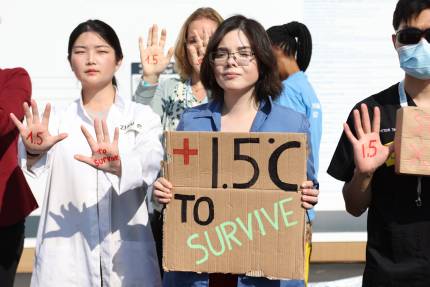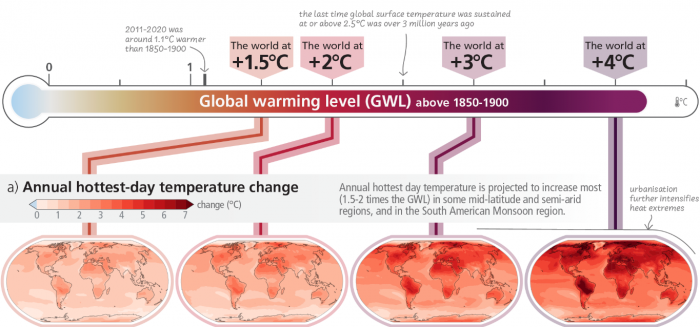
Emissions
At the end of the day, the climate crisis comes down to emissions. When climate scientists talk about emissions, they are referring to emissions of greenhouse gases, which are responsible for global heating and, in turn, the climate crisis. Emissions come, mostly, from burning fossil fuels, and they can be divided into CO2 (the largest single contributor to global heating) and non-CO2 (which don’t contribute as much, but often are much worse than CO2 in the short term). These non-CO2 emissions include gases such as methane (CH4) or nitrous oxide (NO2).
Loss and damage
Loss and damage (often shortened to L&D) is a term that refers to the impacts of the climate crisis that human communities can’t adapt to, either because it’s too severe, or because the affected communities can’t access existing adaptation measures. L&D is a central element of climate justice, as most affected communities rarely are responsible for climate change. Historically responsible countries have committed to creating a fund to compensate for these losses and damages.
For example, the loss of land and freshwater that many Pacific communities will experience due to rising sea levels during this century is considered loss and damage.

In 2022, leaders of 15 low-lying Pacific island nations declared climate change their “single greatest existential threat”. In 2014, Fiji became the first nation to relocate a community because of rising sea levels when salt water invaded Vunidogoloa. Photo credit: Forest Woodward, Matagi Mālohi movie
Mitigation
This term refers to all the measures and technologies that lead to a reduction in the concentration of greenhouse gases in the atmosphere. These include phasing out fossil fuels but also changes in economic systems, behaviours and experimental technologies to remove or capture carbon.
For example, replacing electricity sources from coal thermal plants with solar panels is a mitigation measure.
Adaptation
This term refers to all the measures that respond to current or future climate impacts. They are a way to prepare against the effects of climate change. Often, adaptation measures have positive effects, helping communities improve their livelihoods. However, sometimes adaptation focuses too much on the short term and neglects the long term, which may result in future losses and damages.
Adaptation is a matter of climate justice, as more impoverished communities can’t access adaptation tools in the same way that wealthier communities can.
Scenarios / Pathways
Scientists use many tools to study the future that lies in front of us. And that future depends on the actions we take today. That’s what scenarios and pathways are: they are models that describe what the future will look like depending on how much we emit today. They are projections, not predictions, so they should be used as guidelines, or windows to many possible developments. In addition, the IPCC explicitly recognises that scenarios and pathways don’t make “assumptions about global equity, environmental justice or intra-regional income distribution”.

Projected changes of annual maximum daily maximum temperature at global warming levels of 1.5°C, 2°C, 3°C, and 4°C relative to 1850–1900. Source: IPCC AR6
Carbon budget
A carbon budget is the remaining amount of greenhouse gases that humans can dump into the atmosphere while keeping global temperatures from rising above certain points. Therefore, there is a carbon budget for 1.5ºC and another for 2ºC (and many more!). Carbon budgets are closely related to scenarios and pathways.
The full exploitation of current fossil fuel developments would completely consume our carbon budget for 1.5ºC, which means that fossil fuels need to be immediately phased out and replaced with renewable energies to avoid the worst impacts of climate change.
Overshoot
Some scenarios and pathways show that we may cross certain temperature rise thresholds (such as 1.5ºC), but that it can be reduced again later. This temporary excess of temperature is called “overshoot”. While it’s clear that permanent global heating is worse than overshooting, the latter is not good news either, as that may be enough to kick off some irreversible domino effects.
Levels of confidence
Each statement included in any of the IPCC reports includes (in brackets), the level of confidence that the authors have in that claim. There are five levels: very low, low, medium, high and very high. These reflect the answer to two questions about the statement:
- How robust is the evidence supporting this statement?
- How much agreement is there in the scientific community that this statement is true?
The IPCC tries to reserve any statement with low or very low confidence to areas of major concern, so most of the claims you’ll see have at least medium confidence. That means that most of what you can read in any of their reports is widely supported by either the scientific community, evidence, or, most likely, both.
Disinformation is often found to use these terms to sow division in society, trying to make them appear as if they reflected disagreement and uncertainty, instead of the opposite.
Likelihood
Same as with the levels of confidence, most statements in an IPCC report include a degree of likelihood that reflects the possibility that said statement is true. The scale of likelihood looks like this:
-
-
-
- virtually certain (99-100% likely to be true)
- very likely (90-100% likely to be true)
- likely (66-100% likely to be true)
- more likely than not (50-100% likely to be true)
- about as likely as not (33-66% likely to be true)
- unlikely (0-33% likely to be true)
- very unlikely (0-10% likely to be true)
- exceptionally unlikely (0-1% likely to be true)
-
-
Best estimate
When climate scientists talk about numbers, such as temperature increases or sea-level rise metres, they almost always present these numbers as a range of possibilities. Within this range, they often present a figure that they think is the most likely value, and they call this number the “best estimate”.
For example, if they say: “Continued greenhouse gas emissions will lead to increasing global warming, with the best estimate of reaching 1.5°C in the near term”, that means that we may reach a bit more or a bit less, or a bit before or a bit after, but reaching 1.5ºC in the near term is the most likely.
The post Listen to the science: 10 climate jargon terms, explained appeared first on 350.


0 Commentaires